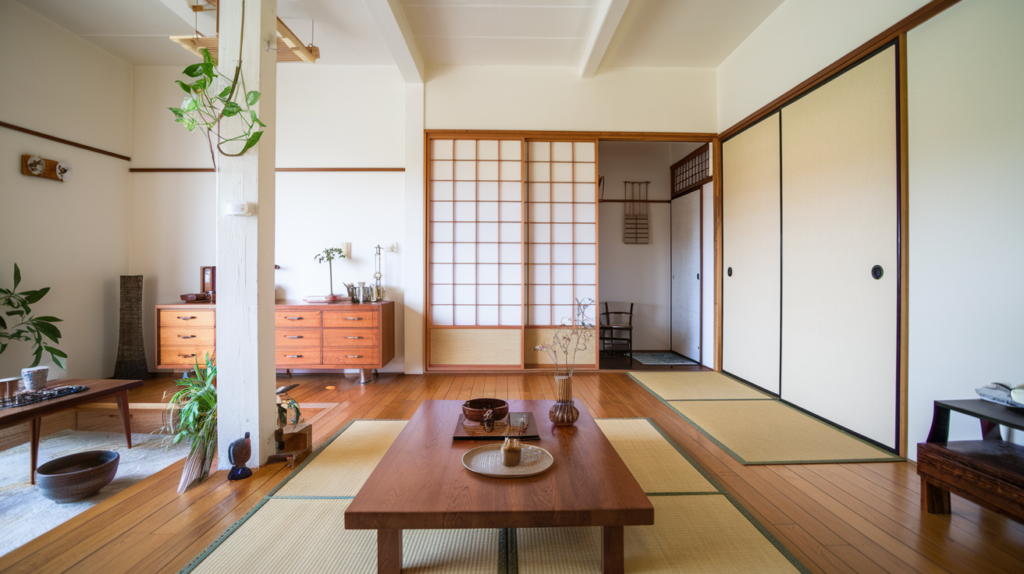Experience the soul-soothing beauty of Japanese Home Decor—a minimalist design philosophy rooted in deep cultural heritage, where every element whispers tranquility, each space honors intentional simplicity, and centuries of artistry shape your home into a serene, mindful sanctuary.
What Is Japanese Home Decor and Why Is It So Powerful?
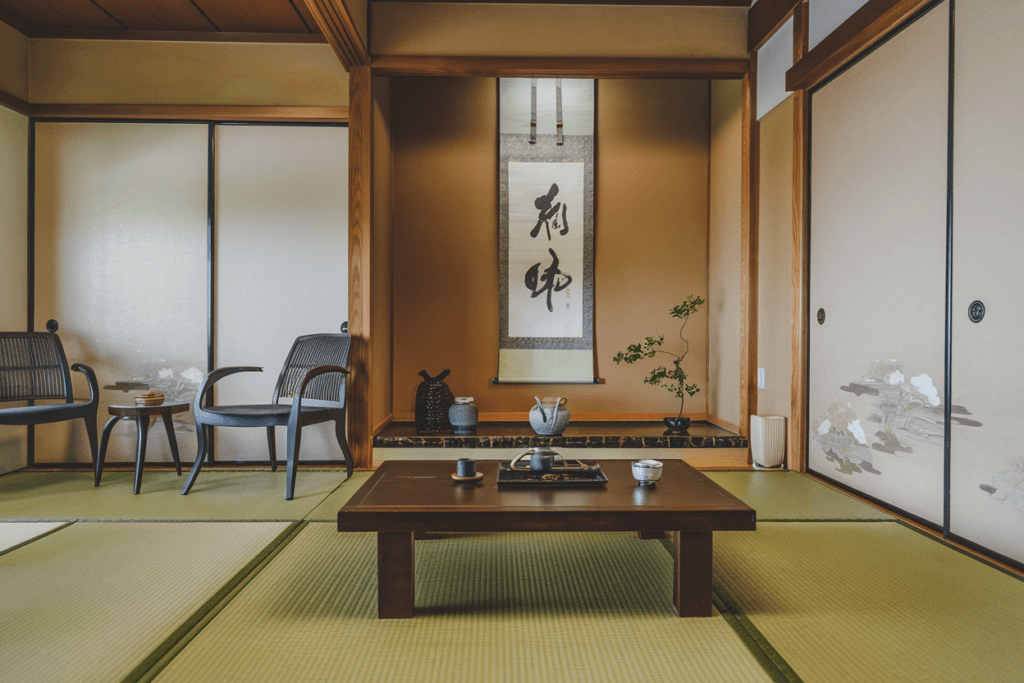
Japanese home decor goes beyond stylistic expression—it creates emotional space. At its core, this aesthetic fosters calm, mental clarity, and spiritual wellness.
By removing excess and celebrating simplicity, it allows us to reconnect with what matters. Japanese homes are designed to promote intention, balance, and restfulness—concepts increasingly vital in the overstimulated digital age.
With rising interest in slow living and sustainable homes, more people are discovering the transformative power of Japanese interiors. From incorporating nature into everyday living to designing flow-friendly layouts, Japanese home decor becomes a form of self-care. It’s not just a look—it’s a way to live gently.
The Core Principles That Define Japanese Home Decor
Kanso (Simplicity)
Kanso speaks to clarity through reduction. The more you de clutter your environment, the more spacious your inner world becomes. This principle guides not only what is removed, but what remains. Items in a room are selected based on how they support your lifestyle—not just your aesthetic. A Kanso-inspired home allows its inhabitants to move freely, think clearly, and feel less burdened by excess.
This is especially powerful in smaller homes or apartments where space is limited. Simplicity here is not about sacrifice but enhancement—it turns space into sanctuary and presence into a daily practice of gratitude and mindfulness.
Shizen (Naturalness)
Shizen honors the organic flow of life and space. Instead of altering materials to look “new,” it encourages their natural essence to shine. A weathered wood table with visible knots and grains tells a story. A handmade ceramic plate, slightly asymmetrical, invites touch and attention. Indoor greenery—like bonsai, ferns, or potted moss—offers calm and purifies the air.
Nature isn’t decoration—it’s integration. Light is filtered, not blocked; seasons are embraced, not hidden. Shizen reminds us that we are part of nature, not separate from it. When homes reflect the natural world, they become deeply comforting places to rest and reset.
Shibui (Subtle Beauty)
Shibui captures the beauty that unfolds slowly. Unlike loud design trends, shibui elements are timeless and quietly elegant. Think of a neutral-toned linen curtain that glows at golden hour, or the smooth texture of a stone basin worn over time. Shibui encourages restraint and depth—design choices that grow on you, rewarding long-term observation. In a shibui home, less is truly more, and every detail feels intentional.
When decorating, focus on layered textures, matte finishes, and imperfect details that tell a story. This approach enhances longevity and creates emotional connection—turning houses into soulful spaces, not just styled rooms.
Wabi-Sabi (Imperfect Elegance)
Wabi-sabi teaches that imperfection isn’t a flaw—it’s where meaning lives. It celebrates the crack in a favorite mug or the fading color of an old rug. These marks are not damage but memory—testaments to use, love, and time. Embracing wabi-sabi in decor shifts the focus from buying new to cherishing what’s already there. It encourages you to let go of the “perfect home” ideal and lean into authenticity.
In practice, this might mean keeping a weathered wood table instead of replacing it or showcasing handmade, uneven pottery over mass-produced wares. It’s design with soul—and beauty that deepens with age.
Key Elements to Include in a Japanese Home Design
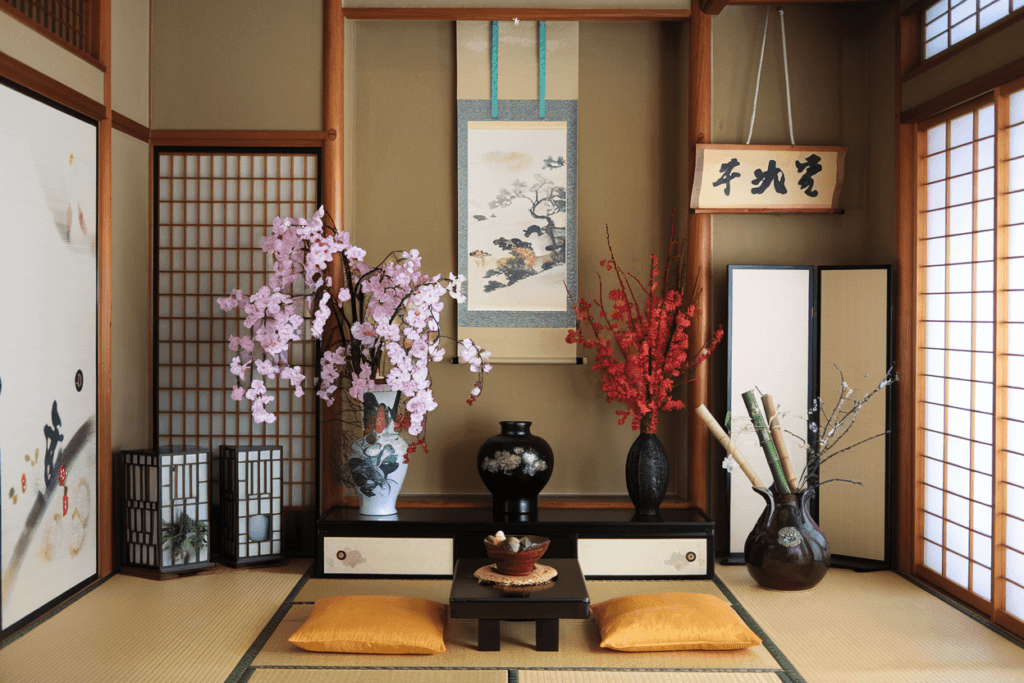
Tatami Mats: Natural Grounding
Tatami mats are both functional and symbolic. Traditionally crafted from rush grass and rice straw, they’re soft, aromatic, and naturally regulate humidity—making them ideal for health-conscious spaces. Walking barefoot on tatami engages all the senses, connecting you physically to the space.
Modern homes can adapt by using modular tatami tiles or placing them under a tea corner or reading nook. Tatami mats also influence room layout, often encouraging low furniture and floor-based living. This style promotes better posture and mental grounding. Embracing tatami is not just a nod to tradition—it’s a meaningful way to connect body and space.
Shoji Screens: Flexible Light and Space
Shoji screens create magic through light. Their rice paper panels soften daylight, diffusing it in a warm, golden glow that transforms the mood of a room. They’re excellent for creating privacy without building walls—making them ideal for urban apartments and small spaces.
In homes with open floor plans, Shoji partitions help define zones without creating visual heaviness. They’re also energy efficient, allowing air and light to flow naturally. Available in both sliding and standing versions, shoji screens can be traditional or modern. Use them to frame a meditation space, separate a reading area, or conceal storage elegantly.
Fusuma Panels: Mobile, Artistic Walls
Fusuma doors are not just functional—they’re living art. These opaque, sliding doors often feature ink or watercolor landscapes, seasonal themes, or abstract calligraphy. They allow you to reconfigure your space fluidly depending on your needs—opening up for guests, closing off for solitude. In modern applications, fusuma-style wardrobes or pantries offer an elegant alternative to hinged cabinets.
Whether painted or plain, they reflect the Japanese belief that functional items should also be beautiful. A fusuma door becomes part of your room’s storytelling—shifting your space as your life shifts. It’s practical design with poetic purpose.
Tokonoma: The Spiritual Niche
The tokonoma is a quiet shrine to stillness. Tucked into the living or tea room, it’s a place to display a single object of beauty: a bonsai, seasonal flower, or hand-painted scroll.
The idea is not to impress but to reflect. Tokonoma evolves with the seasons, teaching you to appreciate time’s passing. In modern homes, it could be a dedicated shelf, wall recess, or mantel that holds rotating symbols of mindfulness. By giving space to a single object, the tokonoma trains your eyes and heart to slow down. It becomes a daily reminder to pause, observe, and reconnect.
Craving alternative decor style that radiates spiritual warmth and tropical calm? Step into the soul-nourishing world of Balinese Home Decor, where handcrafted textures, nature-inspired palettes, and sacred energy converge to turn homes into healing sanctuaries.
How to Decorate Each Room with Japanese Home Decor
Japanese-Style Living Room
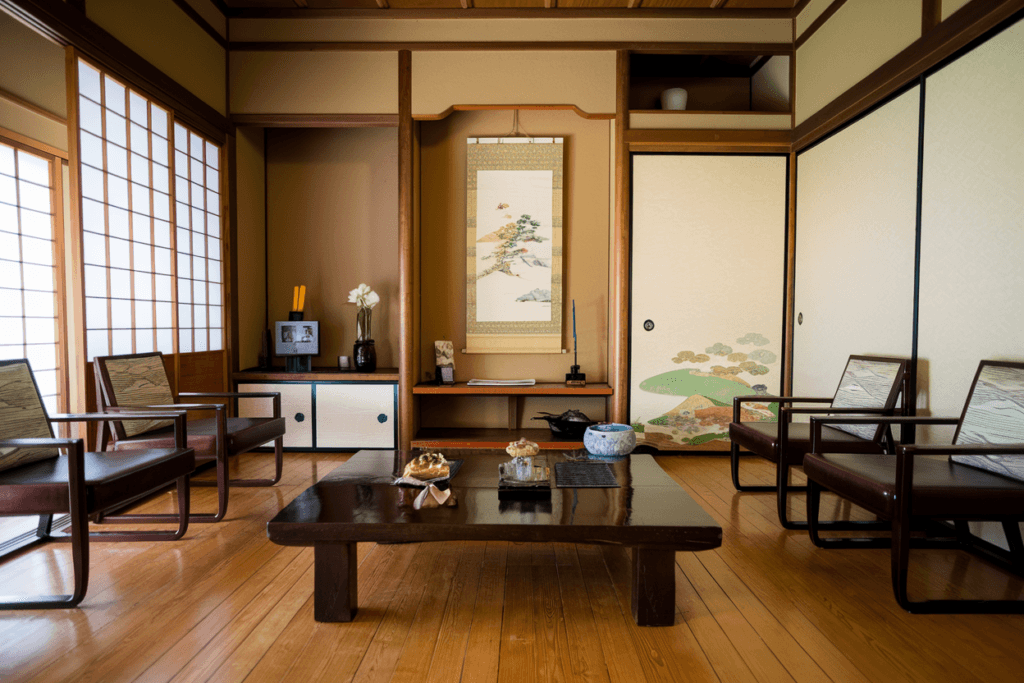
The Japanese living room becomes a place where silence speaks. Unlike Western living spaces centered around screens and stimulation, a Japanese living room is designed for restoration. The use of low furniture such as zaisu chairs and chabudai tables encourages floor-level engagement, which can help improve posture and ground one’s energy. Textiles are kept simple—cotton, hemp, or wool in soft, earthy hues. Every object should invite touch, from smooth ceramic cups to textured tatami mats.
The layout of the room often revolves around flow—how people and energy move through it. Items are not just placed where they fit, but where they belong. Decorative accents are chosen not to fill space, but to mark intention—a scroll, a small sculpture, or a seasonal ikebana arrangement.
The use of indirect lighting, especially from paper lanterns or floor-level lamps, creates ambient warmth. Incorporating these details turns the room into a restorative space, where stillness feels alive and deeply nourishing.
Japanese-Style Bedroom
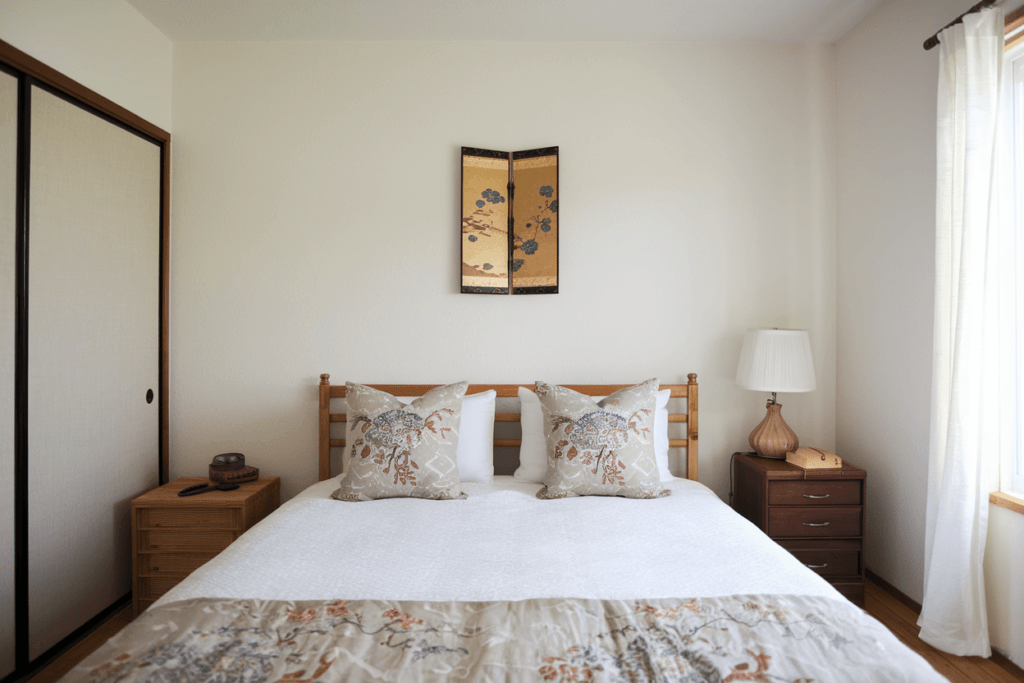
In a Japanese bedroom, everything is designed for renewal. Where Western bedrooms often double as entertainment zones or offices, the Japanese approach keeps this space sacred. The futon is central—its fold-ability allows the room to return to open space by day, symbolizing a fresh start. Even when opting for a modern bed frame, maintaining a low height connects the sleeper to the ground, echoing nature and reducing over stimulation.
Clutter is the enemy of rest. Japanese bedrooms emphasize closed storage and minimal surfaces, allowing your senses to fully unwind. Walls may be bare or feature a single calming piece of art.
A traditional shoji lamp or rice paper lantern gives off a dim, meditative glow—ideal for pre-sleep rituals. Scented incense, such as hinoki wood or jasmine, can be used to mark transitions from activity to rest. Ultimately, the bedroom becomes a temple to sleep and simplicity—a true refuge for the soul.
Japanese Kitchen & Dining
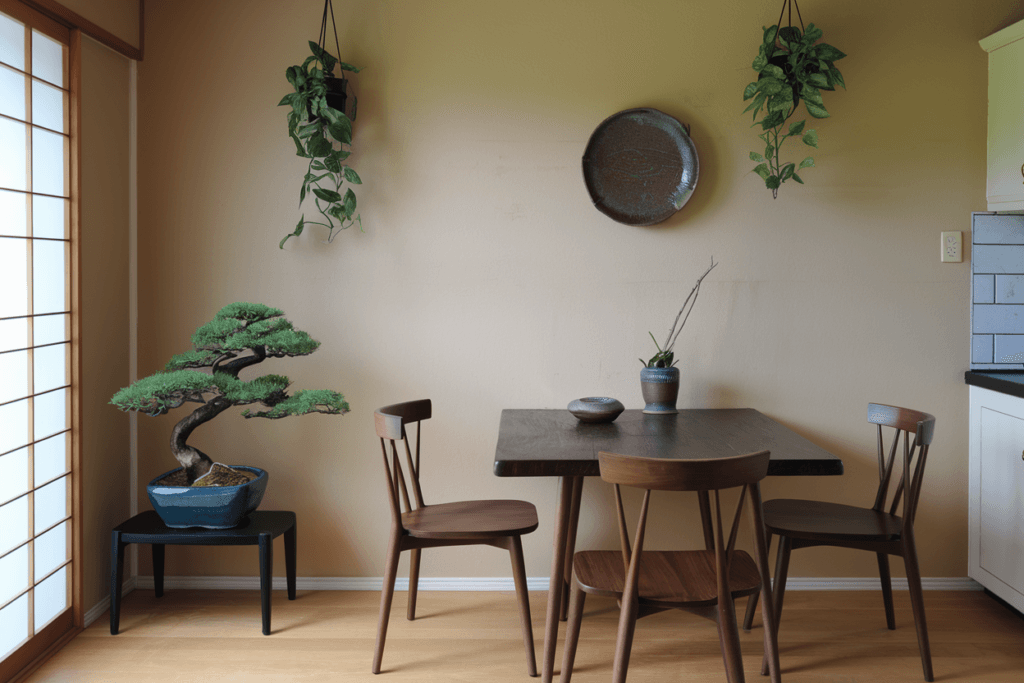
The kitchen and dining area in Japanese homes are realms of quiet reverence. Every item has its place, every surface is clear. The layout promotes efficiency and cleanliness, but also ceremony. Wooden cabinetry with subtle grain, stone sinks, and ceramic dishware create a tactile, organic environment. Cooking isn’t rushed—it’s intentional. Tools are displayed neatly and minimally, reflecting pride in craft.
The dining area often features a chabudai or low wooden table, surrounded by zabuton cushions. Meals are served in individual dishes rather than piled onto one plate—this isn’t just about presentation but about honoring each element of the meal. Whether it’s a bento-style lunch or a tea ceremony, dining becomes ritual.
This intimate setup encourages mindfulness and connection. Even in Western homes, simply adopting clean surfaces, organized tools, and slow meals can bring the soul of Japanese design into everyday routines.
Living by Season: Japanese Home Decor Year-Round

Spring: Celebrate New Beginnings
Spring in a Japanese home is marked by lightness and renewal. Fresh air, pale blossoms, and sunlight filter into rooms as heavy fabrics are stored away. Add touches of sakura pink through cushions or wall scrolls. Opt for thinner curtains that allow natural light to dance softly through the room. You might also include a vase with cherry or plum branches—real or faux—to echo hanami (flower viewing) season.
This time also brings a visual refresh. Consider rearranging furniture to open new pathways, symbolic of forward movement. You may even rotate your tokonoma display to include poetry scrolls or artwork that celebrates nature’s return. Spring is about uplifting energy—clear, gentle, hopeful—and your space should reflect that.
Summer: Cool and Clean
Japanese summers are hot and humid, which is why the decor shifts toward cooling materials. Sudare (bamboo blinds) are hung to block intense sunlight while still allowing air flow. Thin cotton cushions, breezy linen curtains, and even hand-held fans placed by the door become both functional and aesthetic.
Rooms are pared down even further. Clutter holds heat, so surfaces are cleared, and reflective items—like glass vases or shallow water bowls with floating leaves—help cool the eye and the spirit. Some families place wind chimes near windows, their soft tinkle a soothing sound of summer breeze. These small seasonal shifts ensure that the home works with, not against, nature’s rhythms.
Autumn: Warm Tones and Natural Textures
Autumn in Japanese design introduces depth and richness. It’s the season of earthy ochres, russet reds, and deep greens—all pulled directly from the forest. In the tokonoma, dried pampas grass or chrysanthemums might take center stage, while accent pillows or throws adopt heavier weaves in seasonal hues.
Lighting shifts too—from cool, open light to golden, dappled tones. Lanterns are lit earlier in the evening, and the air begins to carry the scent of roasted tea or sandalwood incense. Wood and ceramic gain more focus than bamboo and linen, providing tactile warmth. Autumn decor encourages reflection—marking transitions, giving thanks, and savoring life before the dormancy of winter.
Winter: Cozy and Low-Lit
Japanese homes in winter become dens of hygge-like comfort, but still minimal in nature. The kotatsu table becomes the focal point—a low wooden table covered with a heavy blanket and fitted with a heater underneath. Families gather around it for warmth, meals, and bonding.
Heavier fabrics reemerge: wool, felt, and flannel in muted, warm colors. Lighting becomes even softer, with candles or low-watt bulbs casting golden shadows. The smell of hinoki wood or clove incense may fill the air. Minimalist doesn’t mean cold—Japanese winter design proves that simplicity can feel immensely cozy. It’s about wrapping the space around you like a soft, invisible blanket.
Japanese Interior Philosophy: Beyond Decor

Japanese decor isn’t just about style—it’s an expression of how to live. The philosophy behind the design touches every action, every intention. Ma, the space between objects, mirrors the value of silence between words. It allows both the room and its inhabitants to breathe.
Wabi-sabi is more than accepting flaws—it’s a worldview that transforms stress into appreciation. It slows down consumption and invites gratitude. Rather than chasing perfection, you celebrate stories—like the scuffed edge of your grandmother’s vase or the creak of old floorboards that echo your child’s footsteps.
Practicing ikebana becomes not just a design choice but a meditative act—one that sharpens your attention and deepens your sense of beauty. In essence, these philosophies turn your home into a mirror of your values: peace, respect, impermanence, and deep presence. That’s what makes Japanese home decor so soul-stirring.
Quick Tips to Start With Japanese Home Decor
- Start Small: Don’t overhaul. Begin with one space—a reading nook, a shelf, or your entryway.
- Use One Color Family: Choose natural neutrals like stone, sand, moss green, or charcoal for cohesion.
- Layer Textures: Combine smooth woods, rough clay, soft linens, and woven baskets.
- Embrace Storage as Design: Use washi boxes, wooden crates, or built-in cabinetry to reduce clutter invisibly.
- Let Nature Lead: Pay attention to sunlight. Let it dictate where you place your favorite sitting spot or art piece.
- Rotate Decor: Change your focal point seasonally—keep it fresh, intentional, and alive.
FAQs on Japanese Home Decor
What if I live in a modern apartment?
Japanese home decor principles adapt easily to contemporary architecture. Use space-saving dividers like shoji screens or modular tatami mats to define open-plan rooms. Even without sliding doors or wooden ceilings, you can still achieve the essence—through palette, layout, and purpose.
How do I blend Japanese with other styles?
Start with shared values. If you lean toward minimalism, Japanese elements will blend effortlessly. Japandi—the hybrid of Japanese and Scandinavian—uses wood, clean lines, and cozy textures. The goal is harmony, so focus on shared tones and simplicity.
Do I need to buy authentic Japanese furniture?
Authenticity comes from intention, not geography. A handmade bench from your local artisan may capture wabi-sabi more than a mass-produced “Japanese-style” item. Prioritize natural materials and functionality, then let the design language emerge naturally.
What scent works best with Japanese decor?
Use scent as a sensory anchor. Hinoki wood, green tea, sandalwood, or yuzu citrus oils are perfect. Burn natural incense or use essential oil diffusers with calming notes to create emotional connection within your space.
Is color forbidden in Japanese design?
Not at all—color is welcome, but it must be balanced and quiet. Draw from nature’s own palette: moss, sky, bark, plum, or river stone. Color should calm the eye, not excite it. Let it emerge subtly, in textiles, artwork, or seasonal accents.
If Japanese Home Decor speaks to your soul, wait until you see how cultures worldwide infuse meaning into their spaces—dive into our Global Home Decor Ideas that celebrate identity, emotion, and story through design.

